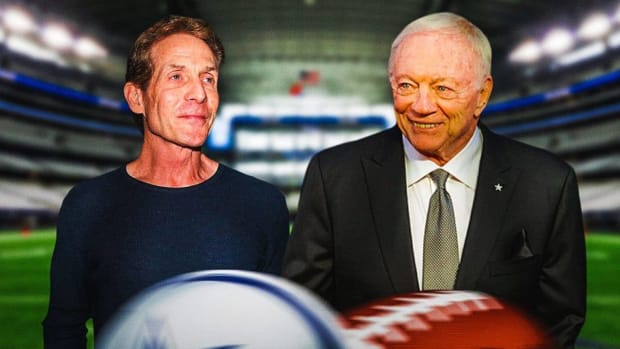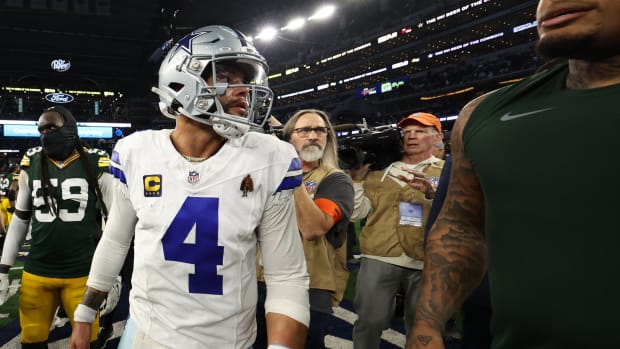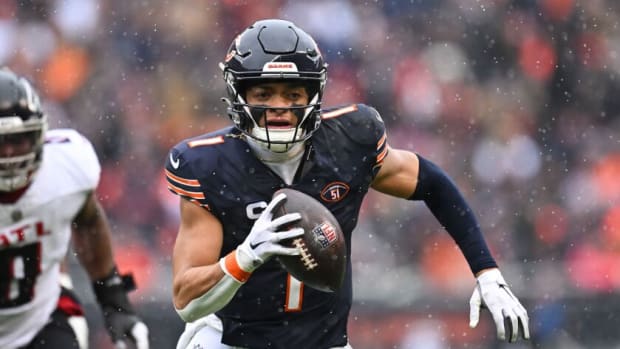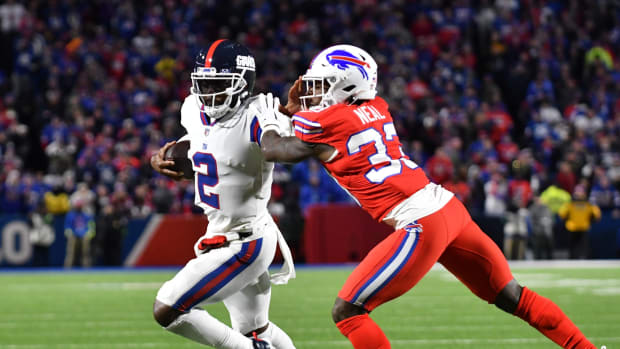2017 NFL draft first impressions: Greg Ward Jr. is the latest spread QB puzzle
It is never too early to start preparing for the next NFL draft. From now through the start of the college football season, FirstImpressions will introduce (or reintroduce) you to prospects of note.
A word of advice: Enjoy watching Houston quarterback Greg Ward Jr., this season.
There will be loads of time to break down his NFL chances (including, in slightly hypocritical fashion, about 150 words from now), but Ward is one of those electrifying players who shines so brightly on the college football stage.
Last season, his first as the unquestioned starter for the Cougars, Ward threw for 2,800 yards and rushed for another 1,100 while accounting for 38 touchdowns (17 passing, 21 rushing). He was at his best in Houston’s biggest games: 236 yards passing and three TDs in a win at Louisville; a combined 391 yards and four TDs vs. Navy; 148 yards rushing and another two touchdowns during a hard-fought victory over Temple; 309 total yards and three touchdowns in a bowl win over Florida State.
When he is on, he is hard to stop, and he could emerge as a Heisman dark horse if Houston upsets Oklahoma on the season’s opening weekend.
So, take Ward’s game in. Because his road will likely be a little rockier come next spring, when NFL teams try to decide exactly what to do with him as a prospect. As a quarterback, he falls into that gray area where front offices get a little skittish: undersized (5' 11", 188 pounds) and coming from a shotgun-heavy spread scheme.
• 2017 NFL draft first impressions: Corey Davis | Johnny Caspers
But Ward is also such an outstanding athlete that the pros could come calling regardless of whether or not he projects as a QB. During the 2013 season and parts of ’14, Ward actually spent substantial time as a receiver and return man before locking in at the quarterback spot.
“He was one of our best three athletes on our team last year,” says Houston offensive coordinator/QBs coach and former Texas quarterback Major Applewhite. “When I was at Texas, he could have been our No. 4 or 5 wide receiver. He’s got that type of speed and versatility.”
Among Applewhite’s primary jobs since arriving as part of Tom Herman’s staff last year has been transitioning Ward from athlete to leader of the offense. And as is often the case with quarterbacks possessing the dynamic dimensions Ward does, step one has been convincing Ward he can be as effective with his arm as he is with his legs.
“You see his struggles or inconsistencies in the passing game, and it wasn’t so much coverage recognition—he knew what the coverage was,” Applewhite says. “Some of his issues were from giving up on the play too early, because he’s so athletic and he can run when he sees space. Or when somebody comes loose on a block. ...
“There were times that he left the pocket early and he moved early. I’ve seen his coverage recognition get better. His biggest strength is his feet and we don’t want to take that away from him, but he can get too fleet of foot too soon.”
Ward did have more plays as the ’15 season went on—not enough, mind you, but more—where he kept himself alive behind the line of scrimmage with the intention of throwing the ball. Those moments featured him spinning or sprinting out of trouble in the pocket, resetting and finding a receiver, which is something Applewhite called a “point of emphasis” headed into ’16.
“The more you do it, the better you have an internal clock in your head,” Applewhite says. “The good thing about Greg is that Greg’s very realistic, so sometimes when you go through some of these [plays] he’s not necessarily trying to challenge you, but he will tell you why he ran. It feels different out there with a face mask on and everything, believe me, I understand it. But there also are times where I say ‘Greg, did you need to take off?’ And he’ll say, ‘No, coach.’ He’s realistic and open with that kind of coaching.”
Herman and Applewhite’s offense is designed to get the ball out quick, often asking Ward to take three steps and fire to his first read. Beyond that is where Houston wants Ward to show more patience.
• MMQB: Rex Ryan remembers his late father and NFL legend Buddy
But the game plan also calls for a bevy of designed quarterback runs and/or read options, meaning plenty opportunities to take advantage of Ward’s gifts ... and take an extra toll on his frame. Ward was banged up multiple times last season, and he wound up missing extended time against Memphis and UConn. The durability concerns go hand in hand with a quarterback of Ward’s stature, particularly when looking ahead to the next level.
When it comes to that stature … well, there’s little Ward can do to make himself taller. Size (or lack thereof) no doubt played a role in Oregon’s Vernon Adams slipping out of the 2016 draft and into the CFL, despite an impressive ’15 campaign.
“That’s always a deal with a 5' 11", 6-foot quarterback, but [Ward has] found ways to move in the pocket and still be efficient as a passer,” says Applewhite, citing Russell Wilson and Drew Brees—the usual suspects—as shorter QBs who have found success. “If he goes to an NFL camp, with the level of speed he’ll see, he’ll need reps because he doesn’t have the gift of being 6' 4", 6' 5" so he can see over top. A lot of their things have to be very mental and very anticipated because they don’t have the luxury of being high in the pocket.”
A transition back to wide receiver could pave Ward’s way into the league. Because of both that possibility and his time under Herman, formerly Ohio State’s offensive coordinator, the comparisons to Texans rookie Braxton Miller will arise. But Applewhite says to hold off: “Braxton’s such a totally different athlete—strength, vertical speed, the power base. That’s just almost unfair.”
Ward will have to carve out his own route. He could even do so as a quarterback, if he makes progress in the pocket this season.
Either way, he’ll be worth the price of admission. Worry about the rest later.
Closer Look: Greg Ward Jr.
Each First Impressions column will feature a deeper dive on our featured prospect, from Sports Illustrated NFL producer Eric Single. Here are his thoughts on Ward:
The fact that Houston could hang with anyone in the country last season is a testament to Ward’s talent as the point man in coach Tom Herman’s aggressive offense. But even at its best, the Cougars’ spread offense still looked like it was (ingeniously) compensating for the limitations of the quarterback. When you watch Ward in the pocket, his school-listed height of 5' 11" looks generous, as does his school-listed weight of 185 pounds. When he is forced to extend the play, Ward would much rather use his legs than his arm and doesn’t keep his eyes downfield once he gets outside the pocket, a habit which has helped other undersized quarterbacks in recent years. He makes the right decision with the ball almost every time until the structure of the play breaks down, at which point he switches back into receiver mode, looking to make a tackler miss and burn the rest.
So what if he switched back into receiver mode for good as a pro? He doesn’t have the size that is expected to help Braxton Miller adjust to the demands of playing wide receiver in the NFL, but Ward works in open space like Miller did after he committed to playing receiver full-time at Ohio State. If he has any hope of getting an NFL shot at QB, he needs to put his ball security issues in the rearview mirror over the final 12 games of his college career.
Ward will help make the Cougars really, really fun for college football fans once again this fall, but NFL evaluators have good reason to project him to any number of other valuable positions on the field that aren’t right behind the center.
Which other talented prospects should you have on your 2017 draft radar? Here are a few more to consider:
Sidney Jones, CB, Washington
The Washington secondary is loaded, led by Jones and safety Budda Baker, both juniors. The former has started all but one of 26 games since arriving on campus. Last season, he notched first-team All-Pac-12 honors after a standout season: 45 tackles, four interceptions and, per the Huskies’ website, a conference-leading 14 pass breakups. Jones and 6' 3" senior Kevin King again should form one of the better one-two CB punches in the land, and both could carry high hopes into the 2017 draft, should Jones bypass his final season of eligibility.
What’s to like: Just about everything. Those tackle and breakup numbers were in large part due to Jones’s phenomenal recognition skills. He is particularly noticeable when a play develops in front of him, staying physical on receivers working back to the ball and sniffing out screen/underneath passes. One of his four picks last season came when he read a delayed screen by USC, dodged a blocker and stepped in front of a Cody Kessler pass. He frequently shades receivers toward the inside, opening his hips away from the sideline, but he has the footwork to utilize the boundary as an extra defender.
• Ranking the NFL’s best inside LBs | OLBs | DLs | Edge players
What needs work: Jones is way ahead of the curve, considering he’s working on just two seasons of experience with no redshirt. He will occasionally get caught peeking on double moves, so quick receivers can get a step or two behind him. He also can get a little blasé against the run—bigger receivers can wipe him out of the picture entirely. There are no major concerns at the moment, though.
Early outlook: The cornerback position projects as one of the ‘17 draft’s better spots. Desmond King, Cameron Sutton, Jourdan Lewis, Jalen Tabor and several others have early-round potential. Jones is right there with him, a potential No. 1 or No. 2 cornerback in a man-coverage scheme.
[youtube:https://www.youtube.com/watch?v=kV6QGITEwOo]
Matt Breida, RB, Georgia Southern
Georgia Southern led the FBS in just about every measurable rushing statistic last season: yards (4,719), yards per attempt (6.48), touchdowns (54) and yards per game (363). Breida was the main beneficiary, churning out 1,609 yards and 17 touchdowns on 203 carries. The speedy 5' 11", 190-pounder was a home run waiting to happen—through the Eagles’ first games of 2015, Breida was turning a whopping 13.1% of his carries into 20 yards or more, per Rotoworld’s Josh Norris. He would add four more such runs down the stretch, including a 75-yard TD scamper vs. South Alabama and this brilliant reversal-of-field at Georgia. Breida finished the year ranked 10th in FBS rushing yards.
What’s to like: Every single time Breida gets the ball, he is a threat to take it the distance. Go ahead and circle him as a combine standout, because on tape he shows 4.4-range speed, which he uses to pull away from second- and third-level defenders. He’s a blur turning the corner and explodes through holes off tackle. No one will confuse Breida with a power back but he can break arm tackles—he had a short-yardage TD vs. Western Michigan in which he ran through a lunging linebacker, then spun off a safety. He can be patient on plays to the edge, waiting for a cutback hole to open.
• The Ryan Family Defense; How Buddy Ryan invented the 46
What needs work: Hearing “option offense” at the college level usually calls to mind Navy’s familiar flexbone attack, with the QB under center. Georgia Southern operates a similar triple-option scheme but does so from the shotgun, so Breida does get some downhill opportunities. He does not run with the same juice between the tackles that he does outside, though, and often looks to bounce runs wide so he can show off his speed. When he stays in his lane, his style boils down to a side-to-side stutter step and then a charge north. While it can be effective, even produce a huge gain here or there, he’s far more dangerous wide. There also is not much to go on when it comes to pass catching or blitz pickups. He is able to chop blitzers when called upon, but it’s rare. And he finished with just three catches for six yards last season.
Early outlook: Figuring out where Breida fits in the NFL will be a challenge for scouts. His speed and lack of pile-moving size makes him a change-of-pace candidate, but will he be able to pick up the nuances of a passing game? A trip to the Senior Bowl, or another postseason All-Star Game, could help him a bunch. The way he strings plays to the sideline, then plants and goes should appeal to stretch zone teams.
Trey Griffey, WR, Arizona
You know the name. Griffey is the son of legendary baseball star Ken Griffey Jr., and in fact the Mariners just selected him in the 24th round of the MLB draft on that basis alone—Trey hasn’t played baseball since before high school. The redshirt senior still has one season left with the Wildcats before any sport-switching decisions could arise. For his sake, hopefully it is more productive than ’15, when a foot injury limited Griffey to six games. He finished with 11 catches for 284 yards (a 25.8 yards-per-catch clip) and a TD. He has 56 receptions and four touchdowns for his career.
What’s to like: This will come as no surprise to anyone who saw his daddy play ball, but Griffey is a straight up athlete. He has an effortless gait and, at 6' 3", covers a lot of ground with his strides. In theory, he’s an ideal red-zone threat, with the ability to go up and get the ball—his first career touchdown came in the 2013 AdvoCare Bowl when he went over top of two Boston College defenders for a 26-yard grab.
• Where Are They Now: Guarded superstar Ken Griffey Jr. is at peace
What needs work: Griffey is far more potential than polish headed into 2016, from his route running to his ability to finish plays. With his frame he should be able to overpower defenders more than he does. And for the impressive hands catches he has made, there have been a few frustrating drops. He must become more reliable going across the middle. Oh, and how about scoring five or 10 touchdowns?
Early outlook: Can Griffey be a big-bodied, go-to receiver for the Wildcats? That role recently was vacated by Cayleb Jones, who now resides on the Eagles’ roster. If Griffey is going to be looked at as a potentially dominant red-zone threat, he has to produce more in those spots this season. His size and bloodlines will land him a chance, although he has ground to cover if he wants it to be as even a mid-round pick.
Harold Landry, DE, Boston College
Now a junior, the 6' 3", 245-pound (as of last year) edge rusher announced his presence during a sensational outing vs. Florida State. In that game last season, a 14–0 Boston College loss, Landry registered 11 tackles, 4.5 tackles for loss and 1.5 sacks. All told, Landry had 60 tackles, 15.5 tackles for loss and 4.5 sacks during his breakthrough sophomore campaign. The Eagles’ offense was an unwatchable tire fire, but their defense ranked first in yards per game allowed (254.3) and second in rushing (82.8), with Landry playing an instrumental role.
• MMQB: Players, colleagues remember Dr. Z | A life in journalism
What’s to like: The TFL total was well-earned—Landry made a habit of dropping inside to blow up plays in the backfield. He is not always the first player off the snap, but when he is, offensive linemen have an extremely hard time handling him. Landry does a lot of work from a five-tech area, with the versatility to handle three-tech or even seven-tech responsibilities. His future could be on the extended end, maybe even in a wide-nine scheme (or at OLB), because he has speed to dart inside when OTs take a false step.
What needs work: While a candidate for double-digit sacks this season, Landry will have to show more of a counter game to get there. Outside of an infrequent spin move, Landry can be over-reliant on his athleticism. Can he drip those shoulders and rip free of blocks? Can he drive a tackle back with his hands?
Early outlook: It’s far from a guarantee that Landry will head to the ’17 draft—obviously, much depends on how he performs this season. But assuming his pass-rushing technique develops in tune with his physical gifts, he eventually will wind up as a legitimate pro prospect. He’s raw, with a base as a sturdy run defender and an upside as a hybrid, three-down edge rusher.




































